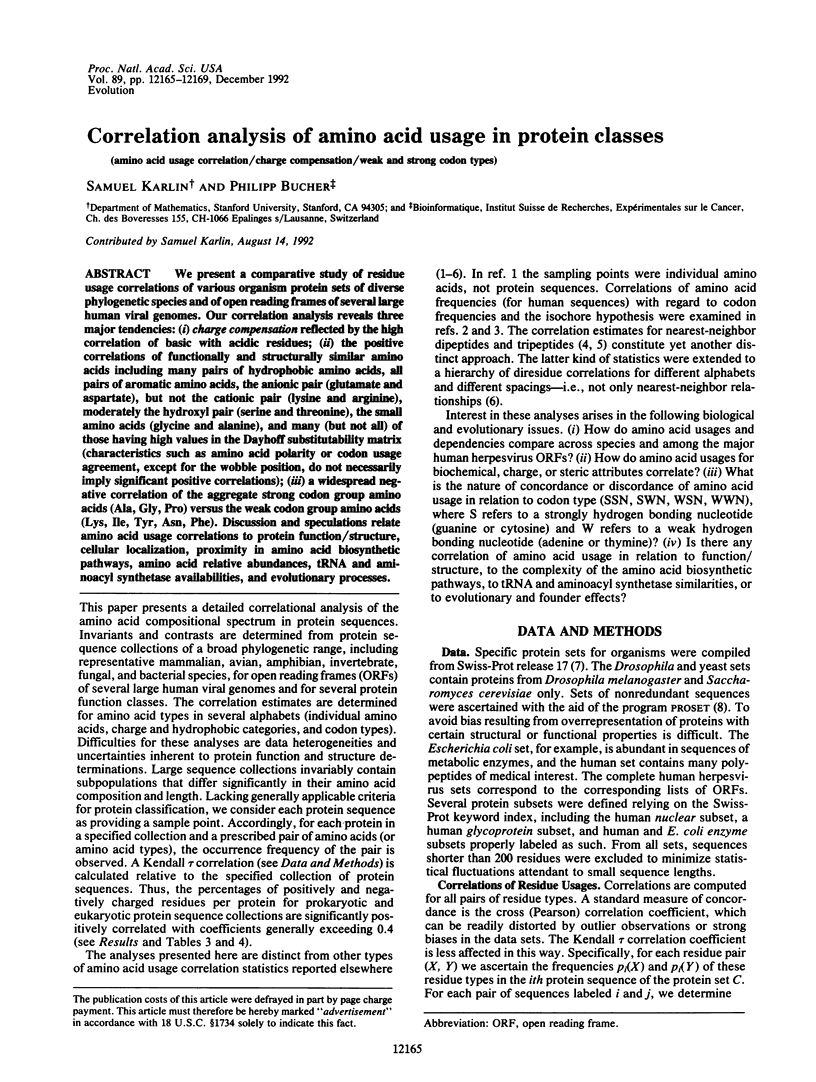Abstract
We present a comparative study of residue usage correlations of various organism protein sets of diverse phylogenetic species and of open reading frames of several large human viral genomes. Our correlation analysis reveals three major tendencies: (i) charge compensation reflected by the high correlation of basic with acidic residues; (ii) the positive correlations of functionally and structurally similar amino acids including many pairs of hydrophobic amino acids, all pairs of aromatic amino acids, the anionic pair (glutamate and aspartate), but not the cationic pair (lysine and arginine), moderately the hydroxyl pair (serine and threonine), the small amino acids (glycine and alanine), and many (but not all) of those having high values in the Dayhoff substitutability matrix (characteristics such as amino acid polarity or codon usage agreement, except for the wobble position, do not necessarily imply significant positive correlations); (iii) a widespread negative correlation of the aggregate strong codon group amino acids (Ala, Gly, Pro) versus the weak codon group amino acids (Lys, Ile, Tyr, Asn, Phe). Discussion and speculations relate amino acid usage correlations to protein function/structure, cellular localization, proximity in amino acid biosynthetic pathways, amino acid relative abundances, tRNA and aminoacyl synthetase availabilities, and evolutionary processes.
Full text
PDF




Selected References
These references are in PubMed. This may not be the complete list of references from this article.
- Aïssani B., D'Onofrio G., Mouchiroud D., Gardiner K., Gautier C., Bernardi G. The compositional properties of human genes. J Mol Evol. 1991 Jun;32(6):493–503. doi: 10.1007/BF02102651. [DOI] [PubMed] [Google Scholar]
- Bairoch A., Boeckmann B. The SWISS-PROT protein sequence data bank. Nucleic Acids Res. 1991 Apr 25;19 (Suppl):2247–2249. doi: 10.1093/nar/19.suppl.2247. [DOI] [PMC free article] [PubMed] [Google Scholar]
- Bernardi G., Bernardi G. Compositional constraints and genome evolution. J Mol Evol. 1986;24(1-2):1–11. doi: 10.1007/BF02099946. [DOI] [PubMed] [Google Scholar]
- D'Onofrio G., Mouchiroud D., Aïssani B., Gautier C., Bernardi G. Correlations between the compositional properties of human genes, codon usage, and amino acid composition of proteins. J Mol Evol. 1991 Jun;32(6):504–510. doi: 10.1007/BF02102652. [DOI] [PubMed] [Google Scholar]
- Green G. A., Jones D. S. The nucleotide sequence of a cytoplasmic tRNAPhe from Scenedesmus obliquus and comparison with a tRNATyr species. Biochem J. 1986 Jun 1;236(2):601–603. doi: 10.1042/bj2360601. [DOI] [PMC free article] [PubMed] [Google Scholar]
- Karlin S., Blaisdell B. E., Bucher P. Quantile distributions of amino acid usage in protein classes. Protein Eng. 1992 Dec;5(8):729–738. doi: 10.1093/protein/5.8.729. [DOI] [PubMed] [Google Scholar]
- Karlin S., Bucher P., Brendel V., Altschul S. F. Statistical methods and insights for protein and DNA sequences. Annu Rev Biophys Biophys Chem. 1991;20:175–203. doi: 10.1146/annurev.bb.20.060191.001135. [DOI] [PubMed] [Google Scholar]
- King J. L., Jukes T. H. Non-Darwinian evolution. Science. 1969 May 16;164(3881):788–798. doi: 10.1126/science.164.3881.788. [DOI] [PubMed] [Google Scholar]
- Luisi B. DNA transcription. Zinc standard for economy. Nature. 1992 Apr 2;356(6368):379–380. doi: 10.1038/356379a0. [DOI] [PubMed] [Google Scholar]
- McCaldon P., Argos P. Oligopeptide biases in protein sequences and their use in predicting protein coding regions in nucleotide sequences. Proteins. 1988;4(2):99–122. doi: 10.1002/prot.340040204. [DOI] [PubMed] [Google Scholar]
- Nagel G. M., Doolittle R. F. Evolution and relatedness in two aminoacyl-tRNA synthetase families. Proc Natl Acad Sci U S A. 1991 Sep 15;88(18):8121–8125. doi: 10.1073/pnas.88.18.8121. [DOI] [PMC free article] [PubMed] [Google Scholar]
- Schachtel G. A., Bucher P., Mocarski E. S., Blaisdell B. E., Karlin S. Evidence for selective evolution in codon usage in conserved amino acid segments of human alphaherpesvirus proteins. J Mol Evol. 1991 Dec;33(6):483–494. doi: 10.1007/BF02102801. [DOI] [PubMed] [Google Scholar]


